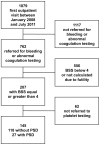Prevalence of disease and relationships between laboratory phenotype and bleeding severity in platelet primary secretion defects
- PMID: 23565241
- PMCID: PMC3614926
- DOI: 10.1371/journal.pone.0060396
Prevalence of disease and relationships between laboratory phenotype and bleeding severity in platelet primary secretion defects
Abstract
Background: The prevalence of platelet primary secretion defects (PSD) among patients with bleeding diathesis is unknown. Moreover, there is paucity of data on the determinants of bleeding severity in PSD patients.
Objective: To determine the prevalence of PSD in patients with clinical bleeding and to study the relationships between the type of platelet defect and bleeding severity.
Methods: Data on patients referred for bleeding to the Angelo Bianchi Bonomi Hemophilia and Thrombosis Center, Milan (Italy) in the years between 2008 and 2012 were retrieved to study the prevalence of PSD. Demographic, clinical and laboratory information on 32 patients with a diagnosis of PSD was used to compare patients with or without associated medical conditions and to investigate whether or not the type and extension of platelet defects were associated with the bleeding severity score (crude and age-normalized) or with the age at first bleeding requiring medical attention.
Results: The estimated prevalence of PSD among 207 patients with bleeding diathesis and bleeding severity score above 4 was 18.8% (95% confidence interval [CI]: 14.1-24.7%). Patients without associated medical conditions had earlier age of first bleeding (18 vs 45 years; difference: -27 years; 95% CI: -46 to -9 years) and different platelet functional defect patterns (Fisher's exact test of the distribution of patterns, P = 0.007) than patients with accompanying medical conditions. The type and extension of platelet defect was not associated with the severity of bleeding.
Conclusions: PSD is found in approximately one fifth of patients with clinical bleeding. In patients with PSD, the type and extension of laboratory defect was not associated with bleeding severity.
Conflict of interest statement
Figures


References
-
- Fuse I (1996) Disorders of platelet function. Crit Rev Oncol Hematol 22: 1–25. - PubMed
-
- Cattaneo M (2003) Inherited platelet-based bleeding disorders. J Thromb Haemost 1: 1628–1636. - PubMed
-
- Nurden A, Nurden P (2011) Advances in our understanding of the molecular basis of disorders of platelet function. J Thromb Haemost 9 Suppl 1: 76–91. - PubMed
-
- Hayward CP (2011) Diagnostic evaluation of platelet function disorders. Blood Rev 25: 169–173. - PubMed
-
- Rao AK, Jalagadugula G, Sun L (2004) Inherited defects in platelet signaling mechanisms. Semin Thromb Hemost 30: 525–535. - PubMed
Publication types
MeSH terms
LinkOut - more resources
Full Text Sources
Other Literature Sources
Medical

